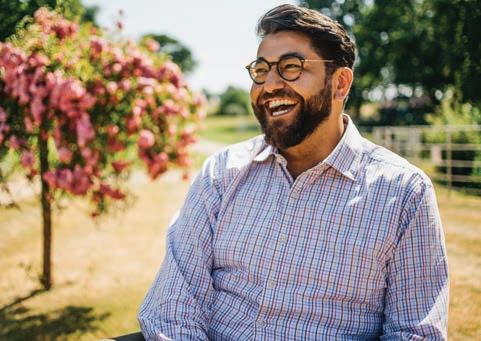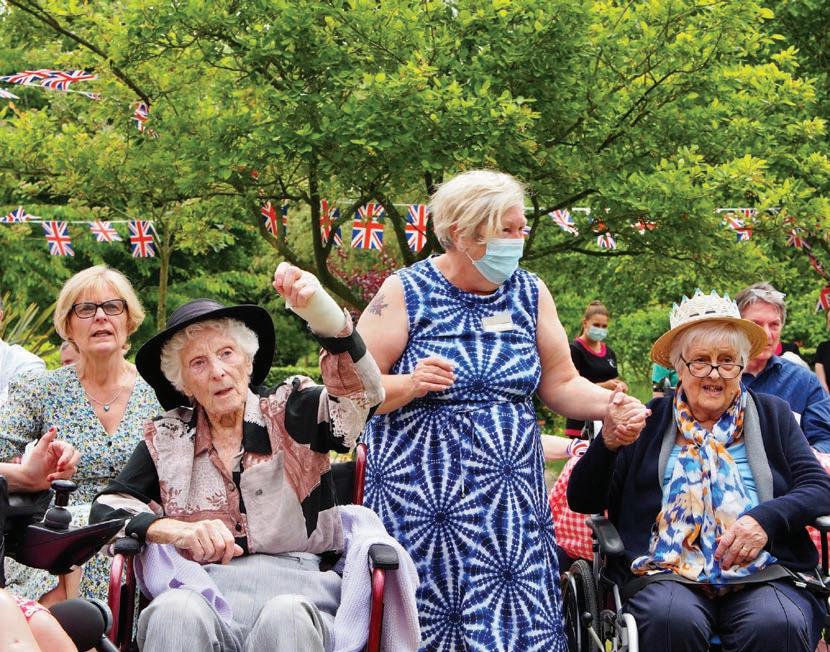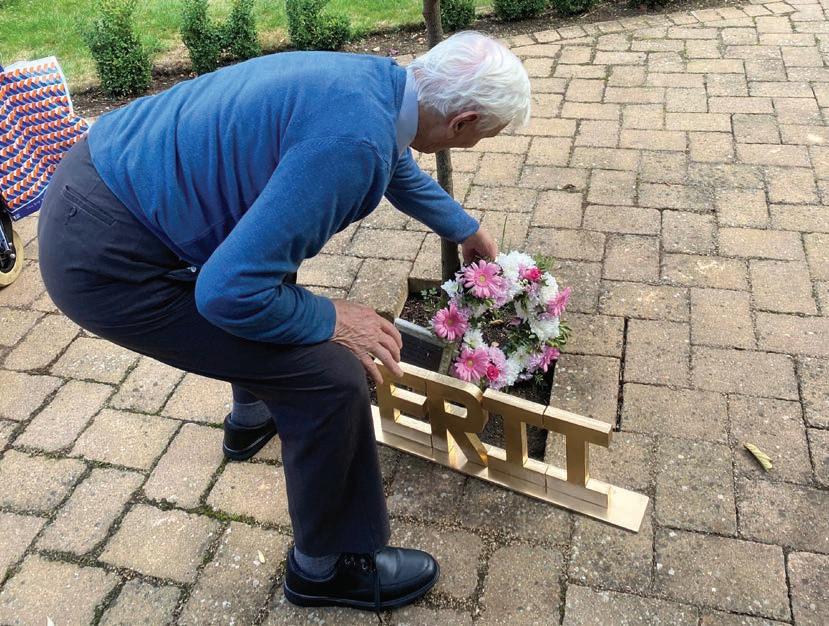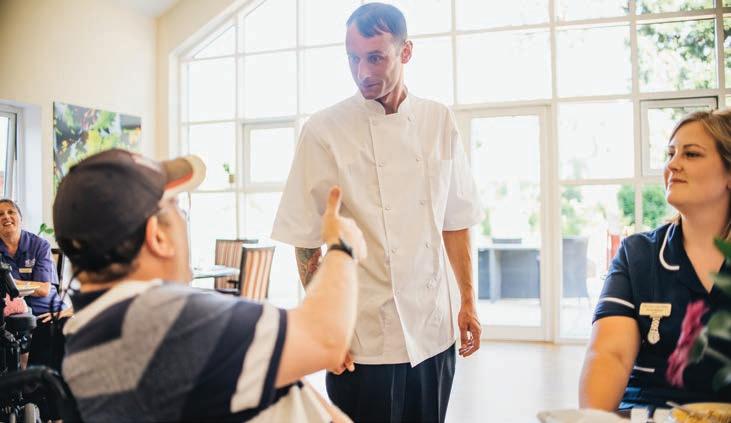
8 minute read
Care with creativity
Lee Peart asks Sanjay Dhrona, managing director of Outstanding-rated The Close Care Home in Oxfordshire, for his recipe for success
Led and inspired by Dhrona, The Close Care Home is one of a handful of care homes in England with Outstanding in all five key lines of enquiry.
Coming from an events background, Dhrona took on the family-run home in 2015.
“Our family bought the home in 1989 as a joint venture with Bupa after a deal with Dr Chai Patel,” Dhrona says. “It was an old mock Tudor mansion that had grown and grown. We had added purpose-built units and conversion units. In 1992 a team came on board and ran the home really beautifully. They left to focus on their own project in 2012 and the team that we brought on board then didn’t understand The Close Way which was its core as a family-run home.”
When asked to define The Close Way, Dhrona answers: “We know what we need to do and we look at it – and then we look at how we can do it. It’s essentially to understand our people and to do things with a streak of independence and creativity and knowing that you can absolutely try something new. There’s no harm in trying something totally crazy if it goes wrong because we would have made sure that it can’t go too wrong.
“That sense of empowerment we give to our team facilitates that creative culture. It’s care and creativity mixed together. It’s about how we take situations and improve the outcomes and support people. Sometimes it’s about how we can respond immediately to their change of needs.
“It’s super inclusive. Our team has a gay brown leader in a very white part of the country in rural Oxfordshire. I speak informally to the residents – I don’t sir/ma’am them. It’s about an authentic experience. We remember to be respectful but it’s authentic.
“Part of our belief system is that everyone is really equal here. People have a voice. They are included from residents to stakeholders and especially the team who are very much empowered. We can get the ball rolling but it’s their job to deliver this amazing thing. It’s not about credit or reward because everyone then has ownership of it.”
Dhrona explains that The Close is one of the few English care homes to have an Outstanding in Safe because of, and not despite of, its positive risktaking approach which allows residents to live happier, more fulfilled and ultimately healthier lives.
“One resident who moved here two years ago was in hospital every month for a week to 10 days and has not been in hospital since she moved here,” Dhrona observes. “That’s because of the way we care for her and the knowledge and practice that we have put in place around her.”
Having a single home to look after has enabled Dhrona to develop a unique family culture at The Close through being a present and hyperengaged owner and director.
“I am in the office at least four or five days a week including weekends and late nights,” Dhrona says. “I know our residents and I know our team.”
Add to this, The Close’s agility through being a single home and completely independent operator, and you have a powerful formula for success.
“What makes us really different is our complete agility,” Dhrona explains. “We are a complete independent; we have no back office system. If you don’t see it here in my office, it doesn’t exist.
“The minute we see something, whether it’s my team or me, we can act on it really quickly which sometimes larger groups will struggle to do because they have to process across everyone.”
Although The Close is larger than today’s typical 60-bed purpose-built home, at 90 beds, Dhrona is still able to get to know his team and every resident and be “as agile as we need to be to suit that resident”.
The person-centred approach begins even before a resident is admitted to the home.

“We have three people who go out and do admission assessments,” the managing director explains. “We have residents who have taken four months to bring on board. That’s not a sales process, it’s the safety mechanism that we trigger. We want to make sure that our team are trained up and ready and the resident is comfortable with the team who are coming on board.
“We have a very holistic way of sharing information so that everything goes across the board because everyone is trained and understands their responsibilities when it comes to GDPR and data privacy and information privacy and respect for our residents.
“Because everyone has access to the right care planning system and understands it, they become really knowledgeable on the resident before they move in. Our assessment process is very tailored to us. It’s not just a standard one. We know so much about them before they arrive so that we can flex and really develop something that is person-centred and personal to them.”
The managing director explains that developing the right care plan is key to laying the foundation for exceptional care.
“The CQC has a big focus around making sure that people’s fingerprints are all over their care plans,” Dhrona observes. “We make sure the residents are involved and they really know what the home is before they come so that when we meet them and get to know them in those first few weeks of settling in we can really turn on a dime very quickly.”
“We have a very holistic way of sharing information so that everything goes across the board because everyone is trained and understands their responsibilities when it comes to GDPR and data privacy and information privacy, and respect for our residents.”
Dhrona said The Close was able to meet the individual needs of residents through constantly listening to them and acting on their feedback.
“We do our resident meetings every month rather than the requirement of once a year,” he explains. “We found that one of the residents had a > passion for Japan and so thought ‘why don’t we serve sushi across the home?’ But then we realised that not everyone would like that so we gave him a whole day where he could have a sushi lunch with a few residents who also wanted to have it, with everyone else having a Japanese influenced lunch.
“We developed the idea into a whole day of Japanese-related activities to include everyone. In the morning the residents made origami and in the afternoon they watched Memoirs of a Geisha in our cinema. That one resident got to set the tone for the whole day in the home as you would in your house if you were having visitors in your home.
“You can also spread the feeling that a resident has ownership of everyone in the home. Next week it will be somebody else’s day. That’s just something that came up in a home meeting because the chef was there and the activities person was there and I was there, so we made a decision and we rolled with it.”

Through avoiding team silos, The Close takes a ‘super connected’ approach to care and innovation.
“In our bistro which is utilised 9 to 5 Monday to Sunday our chefs make beautiful biscuits and cakes,” Dhrona explains. “We bought a packaging machine so we package everything here and put the chefs’ faces on it. Our chefs are around the building and not siloed to just the kitchen; they take the trolleys up and plate a few meals and see the residents and hold the chefs’ club. It feels nice for a resident to get a biscuit in a little package. They get to open it or it’s opened for them and they see the person who has cooked their food so there’s a connection to it. That’s the difference in the innovation that we have.
“A lot of people assume that innovation is just technology,” Dhrona continues. “A graph telling you something is not going to be meaningful in any shape or form until you can use it to adapt your practice in your home. A lot of providers are rightly digitising. The digital software that they are producing gives them so much information back. That information only has value if you look at it, think about it, work out what it’s actually telling you, and then change your practice and your service offering based on that information. The problem at the moment is that people feel that just going digital is innovative enough when actually innovation is mixed with creativity. That’s the bit that we really excel in because we have a culture that stimulates and encourages creativity with our residents and our team members.”
In a further innovation, The Close has developed a creative and fun way of gathering feedback from residents.
Residents, staff and families are asked each week what the home can do better. They vote by placing foam balls in Perspex tubes in the home’s reception.
“We set a question every week which means we can listen,” Dhrona explains. “We can immediately look into that and ask the resident, staff and families and then form an opinion. We can discuss it the next week at the heads of department meeting and look at what we are going to do to fix it and then we can ask the same question and see if we have acted on what we’ve heard. We get to learn very quickly and that’s innovative.
“It’s a different interactive way for residents to have a say in their care, which also provides some exercise. People feel like they are voting and it’s very empowering.”
The care home leader explains how he takes the same listening and responsive approach in meeting the needs of staff.

“We used the same voting system to find out what staff’s preferred pay day was. I have worked in an environment where you get paid the week before Christmas, but we realised that January is a long month and everyone is poor in that month. So we asked the question and they told us they didn’t want to be paid the day before Christmas and wanted to get paid as normal on the 28th and so we changed our practice.
“Now every year to make 100% sure in November we ask the team when they would like to be paid – before during or after Christmas. If somebody says they need an advance to help them buy presents that’s fine as well.”
The Close provides further financial support to staff through loans which they are allowed to pay back in instalments.
Through his role as a board member of The Outstanding Society, Dhrona actively pioneers innovation and shares best practice across the care home sector.
“It’s now open to every single provider where previously it wasn’t,” Dhrona says. “Our board decided we wanted it to be an absolutely inclusive space. You don’t have to be Outstanding to be a member. It’s for the improvement of the whole sector.”
The managing director says being open to learning from others was key to his home’s success.
“We are not stupid to think that we are the best,” Dhrona explains. “We might be up there, but we spend a considerable amount of team learning from others. Being Outstanding is one thing, but remaining it is another. We don’t think that we are number one, we are happy to learn and adapt and steal ideas and then put our spin on it.”
It’s this open and all-inclusive approach that makes The Close one of the very best care homes in the country as well as a beacon of excellence for others to follow.









